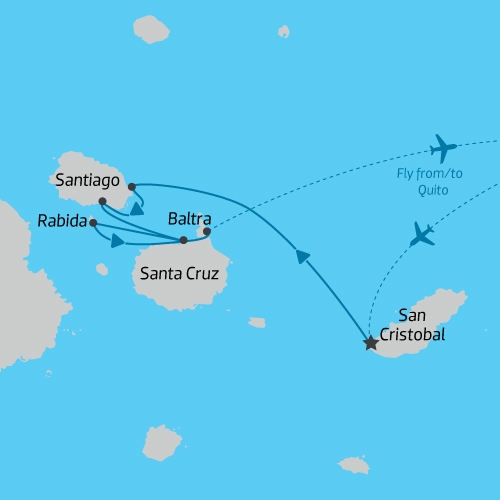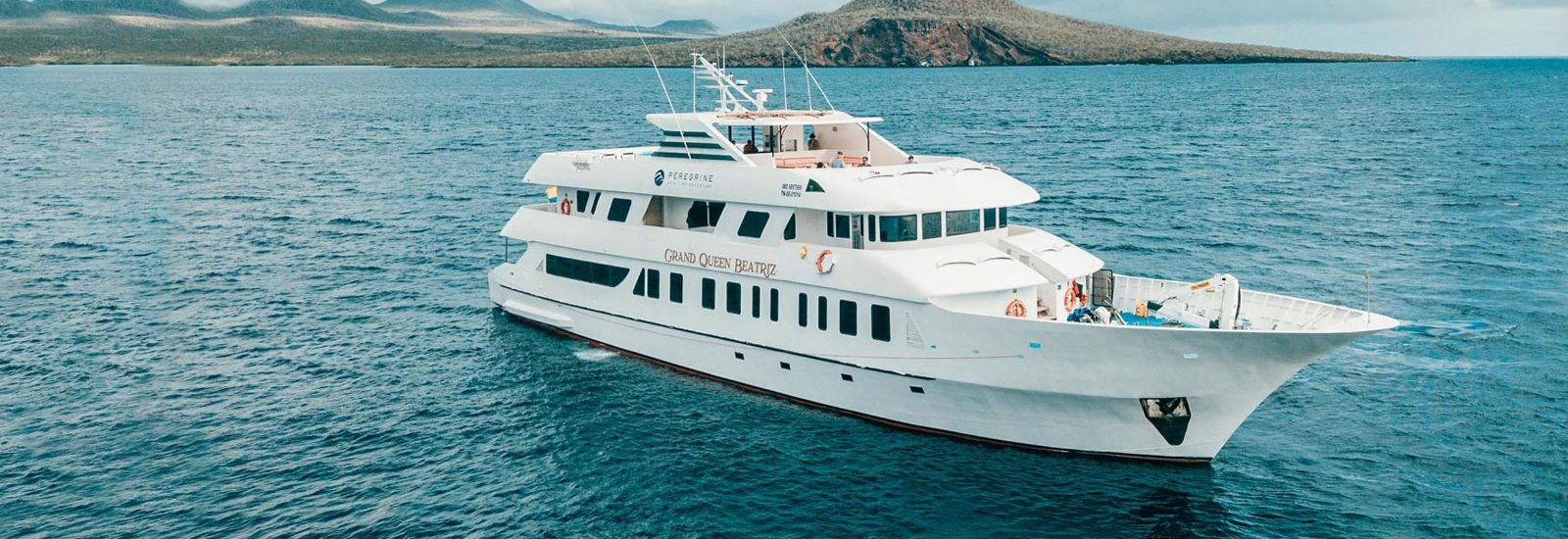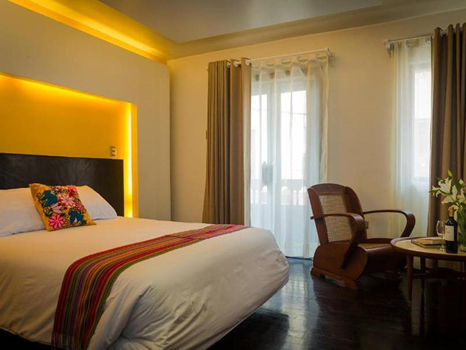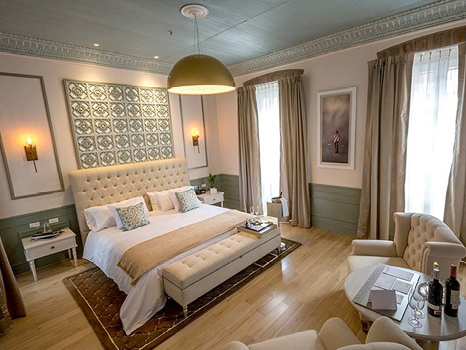Classic Central Eastern Islands | Grand Queen Beatriz
10 Days
From USD 8,425
Trip Code: ECTSGCEI
DIFFICULTY RATING: 2 (light adventure)
Start: Quito, Ecuador
Finish: Quito, Ecuador
SHIP: Grand Queen Beatriz
 Destination
Destination
Ecuador, Galapagos Islands, South America
 Departure Date
Departure Date
Selected Saturdays
 Meals
Meals
Breakfast at the hotel and all meals, water, tea & coffee while onboard your cruise
 Transport
Transport
Group transfers throughout the itinerary
 Accommodation
Accommodation
Cabin on board ship & hotel
Enquire Now


 Included Sightseeing
Included Sightseeing
Daily excursions, panga rides, shore landings and expert briefings while onboard
* Itinerary is subject to change depending on weather conditions and government regulations.
OVERVIEW
Set sail aboard the Grand Queen Beatriz on this incredible 10-day tour of the Central-Eastern Galapagos Islands. Witness the spectacular volcanic landscapes of Bartolomé with its spatter cones and lava flows as you look out for Galapagos penguins and lava lizards. Explore Espumilla Beach, a nesting site for marine turtles and visit the old pirate haunt of Buccaneer Cove. See the sea lions on the black sand beach of Puerto Egas and the nesting sites of magnificent frigatebirds and blue-footed boobies on North Seymour. Snorkel with sea lions and turtles, see Galapagos giant tortoises in their natural habitat and learn the history of the abandoned barges at Las Bachas. This is an incredible voyage of discovery.
Check out some of the other cruise itinearies on the Grand Queen Beatriz: 10 Day Central Southern Islands, 6 Day Southern Islands, 7 Day Southern Islands, 6 Day Central Islands, 10 Day Southern Islands
ITINERARY

On arrival at Quito's Mariscal Sucre International Airport you will be met and transferred to your hotel. The remainder of the day will be at your leisure.
A welcome meeting will be held in the evening at either 5pm or 6 pm when you meet others travelling with you on your cruise to the Galapagos Islands. Please check with hotel reception or check the reception notice boards for the time and place of the meeting for your trip. As today is an arrival day, you can arrive at any time as there are no activities planned until this important meeting.
If you can't arrange a flight that will arrive in time, you may wish to arrive a day early so you're able to attend. We'll be happy to book additional accommodation for you (subject to availability).
Quito sits at high altitude under the towering Pichincha volcano. It is a beautiful city, arguably one of the most beautiful in South America. The city stretches along the valley and is surrounded by the Andes. The Old Town of Quito is awash with history, with more than 30 churches to explore, and a number of fascinating museums. La Compania de Jesus is considered to be the most beautiful and ornate churches in the Americas. The city's oldest street, Calle La Ronda, is well worth exploring.
As this trip spends very little time in Quito, we recommend you spend a few extra days before or after your trip to experience all the city has to offer. You may even wish to explore further beyond the city and visit Otavalo, Cotopaxi, the Cloud Forest or the Equatorial Monument.

This morning you will be transferred to the airport for your flight to the Galapagos Islands. Please note the pick-up time will usually be as early as 4:30 am (a boxed breakfast will be provided), as the airport is a one-hour drive away and you must allow for delays and check-in times. (Your tour leader will confirm this time with you at the Welcome Meeting on Day 1).
The flight to the Galapagos will make one stop in Guayaquil to pick up other passengers. (Total flight time is about 3.5 hours).
On arrival in the Galapagos, you will be met in the arrival hall of the airport (look out for 'Grand Queen Beatriz' signs) by a transfer guide and transferred to our catamaran - ‘M.Y. Grand Queen Beatriz’, anchored on the other side of Santa Cruz Island. Our transfer guide will take you on a short trip via airport bus to board a public ferry across the Itabaca Channel to Santa Cruz Island. Once you reach the Island, you will board a private bus to Puerto Ayora, the main port of the island. Here, there will be two dinghies to transport you and your fellow travellers to the 'MY. Grand Queen Beatriz'. Once on board, cabins will be assigned and there will be a welcome briefing and safety drill. You will then get to meet our crew members and get to know your naturalist guide while enjoying a delicious lunch. (Please note that all transportation costs are included).
This afternoon you will travel into the interior of the island to visit the highlands site of ‘Galapaguera of Cerro Colorado’ (Red Hill) where the national park has established a breeding program and information centre for tortoises. Here, we will be able to see giant tortoises in their natural habitat and learn all about their origin, evolution and their threatened future.
Please note the Transit Card & National Park Fees are not included in the cost of the trip as they need to be paid locally: There is a US$20 Galapagos Islands transit card fee that needs to be paid at the airport in Quito prior to departure to the islands.
All visitors must pay the Galapagos National Park fee of US $200 upon arrival at the airport in the Galapagos. If your trip visits Isla Isabela, there is also port fee of US$10 which is to be paid locally. These fees are to be paid in cash.

Isla Bartolomé (Bartolomé Island) is one of the most spectacular volcanic landscapes in the Galapagos, full of parasitic spatter cones, lava flows, Galapagos penguins and lava lizards.
It is a relatively new island in the archipelago and traces of its volcanic past can be seen everywhere, as evidenced by the amazing lunar-like landscape.
The Pinnacle Rock is one of the most photographed sites in the Galapagos – an abrupt jag of rock protruding from the earth like a tooth, while nearby two golden bays back onto each other.
You can hike to the top of a once-active volcano here (360 wooden steps), and enjoy superb views across to Sullivan Bay, on nearby Santiago Island. If you are in luck you might catch a glance of the Galapagos Hawk here. You also have the opportunity to go snorkelling with plenty of tropical fish, starfish, white-tipped reef sharks, rays and hopefully penguins.
On Santiago's eastern coast sits Bahia Sullivan, also known as James Island. Here you walk on Pahoe-Hoe lava, from an eruption that occurred in 1897, and witness the colonisation of plant species since the last eruption. Hopefully see some marine iguanas, Sally Lightfoot crabs, sea lions, finches, turtles, sharks and penguins. On a walk, your guide will explain the geological history of the islands.

Today you will visit some wonderful places. Espumilla Beach, on the northern coast of Santiago Island in James Bay, is one of the most idyllic locations in the Galapagos Islands and is an important nesting site for marine turtles. With large waves, it is also often a favourite amongst beach lovers.
Potentially we will see Galapagos hawks up close, ghost crabs, blue-footed boobies (often plunging for fish) and brown pelicans. It is also well known for its palo santo forest and some extraordinary lava formations.
You will also visit Caleta Bucanero (Buccaneer Cove), a natural monument of rocks caused by sea erosion. This cove was used by pirates to careen their ships. It is a place of local legends and stories! It is also where Darwin camped for nine days while making his study of the islands and their wildlife. If conditions are favourable, you can enjoy some further snorkelling.
Puerto Egas is a black sand beach located on the west side of James Bay and northwest of Santiago Island. South of the beach is Sugarloaf Volcano, which has deposits of volcanic tuff. This site is named Puerto Egas, after Hector Egas who last attempted to mine salt here. The walk along the beach offers hundreds of marine iguanas and Galapagos sea lions. You will also see amazing tidal pools formed from ancient lava flow and home to sponges, snails, hermit crabs, barnacles and fish. Snorkelling with the seals always offers the possibility of thrilling encounters.

Today you will visit Santa Cruz, the second largest island in the Galapagos.
The small town of Puerto Ayora is the economic centre of the archipelago, and home to the Charles Darwin Research Station. As well as undertaking vital conservation work, the station also makes for interesting exploration and offers the best opportunities for close encounters with giant tortoises. You will also observe baby tortoises and land iguanas.
Afterward you will head up into the highlands for a total change of scenery. Beginning at the coast you'll travel across Santa Cruz through the agricultural region and into the misty forests with the journey taking about 45 mins. This is a lush humid zone containing miconia bushes, scalesia and inactive volcanic cones. Santa Cruz has more endemic plants than any of the other islands and you are likely to see Galapagos giant tortoises in their natural habitat and perhaps even the bright red feathers of a vermillion flycatcher!
Today there will be some passengers leaving the tour and some new passengers joining.

Today you will take a morning excursion to Isla North Seymour (North Seymour Island) which is one of the most visited islands in the Galapagos. The trail on North Seymour crosses inland through the island and then explores the rocky coast. Along the way the trail passes colonies of blue footed boobies and frigate birds.
The magnificent frigate bird, a large black bird with a long wingspan, and a hooked beak, is extremely fast and has excellent vision. Frigate birds are known for the large red pouch on their necks. During mating season the males throw back their heads, inflate the pouch (sometimes to the size of a soccer ball), and shake trying to capture the attention of female frigates.
Boobies and frigates have an interesting relationship. Sharing the same nesting area on North Seymour, blue-footed boobies nest on the ground making their nests from the twigs of the palo santos trees, while the frigate birds nests just above them in the saltbushes. Your walk is followed by snorkelling where you will find a great variety of fish and possibly white-tipped reef sharks, rays and sea lions.
After lunch you will visit the small sandy island of Mosquera, a relaxing, picturesque stop situated between Baltra and North Seymour. Along the rocks and in the tide pool, Sally Lightfoot crabs (red lava crabs) scamper back and forth, skipping across small pools of water in search of food. These crabs with their bright red shell tops and blue under shells are stunning against the black lava. The island also has a very large colony of sea lions as well as a sizeable resident brown pelican population. Depending on the tides and visibility, you may have a chance to go snorkelling here.

Today you will take a morning excursion on a 'panga' to Caleta Tortuga Negra (Black Turtle Cove) - a red mangrove wetland on the north shore of Isla Santa Cruz. You will paddle among the cove’s peaceful waters, for your first taste of the underwater riches of this region – it’s a wonderful place to see green turtle and is a nursery for golden cow-nose rays, eagle rays and Galapagos sharks. There is also abundant birdlife, such as the yellow warbler and lava heron. This is also a breeding area for turtles, so it is not uncommon to see them mating.
In the afternoon, cruise over for a walk on Cerro Dragón (Dragon Hill) this afternoon - one of the best places to see land iguanas in the islands. From our dry landing we walk to a brackish lagoon frequented by lagoon birds including stilts, pintail ducks, sandpipers, sanderlings and occasionally flamingos. Further inland, the trail offers a beautiful view of the bay and the western area of the archipelago. This area is a nesting site for land iguanas, which is constantly monitored and assisted by the Charles Darwin Research Station. The arid-zone vegetation makes for a rewarding location for birdwatching with Darwin's finches, Galapagos mockingbirds, the endemic Galapagos flycatcher and yellow warblers all regulars here. The path can be challenging but you will be well-rewarded with a spectacular view of the bay!

Sombrero Chino is a small islet located near the south-east coast of Santiago. It's shaped like a Chinese hat (Sombrero Chino) when seen from afar, and is geologically fascinating, with many lava tubes leading from the cone to the coast. We approach Sombrero Chino via a beautiful crescent-shaped, sandy beach that is home to sea lions and Sally Lightfoot crabs. Opposite Sombrero Chino, on the rocky shoreline of nearby Santiago, Galapagos penguins are often seen. We follow a trail that circles the cove and passes through a sea lion colony and innumerable marine iguanas. The cove also offers some great snorkelling opportunities, hopefully with penguins and sharks.
Isla Rabida, also known as Jervis Island, is a tiny island sitting roughly five kilometres south of Santiago and is one of the most striking of the archipelago. Introduced species were eradicated in 1971, meaning that the indigenous wildlife has now been returned to a state of splendid isolation. Additionally, volcanic activity here has produced vivid, fantastical colours, not least the beaches of red sand and cliffs of scarlet.
From the shore, the trail leads through to what is one of the finest lagoons in the Galapagos for viewing flamingos. Rabida is also a wonderful place to spot nesting pelicans. Elsewhere, pintail ducks, marine iguanas and sea lions are all present. There is an opportunity for snorkelling in a place where sea stars, damsels, gobbies and surgeon fish are numerous.

As flights to the mainland from Galapagos depart mid morning, it is an early start for our last morning on the islands. Depending on the time of our flight, our time spent on this final excursion could be limited.
As you will be leaving the boat this morning, please remember that if you have enjoyed the services provided by your guide and crew, a tip would be very much appreciated by them. As a guideline we recommend each passenger consider US$15 per day for the crew and US$10 per day for your guide. You can leave tips in envelopes that are placed in your cabin on the last day of your journey.
Today you will take an early morning excursion to Las Bachas, which was so named after the barges abandoned by the American Navy here in the 1940s. The sandy, white beaches of Las Bachas on the north shore of Santa Cruz Island are a nesting site for the Pacific green turtle, and marine iguanas are also commonly seen. The sand here is particularly white and soft as it is made of decomposed coral.
The rocks provide great snorkelling and are the perfect habitat for the Sally Lightfoot crabs, which are plentiful on the island. A saltwater lagoon near the beach is home to flamingo and whimbrel, and look out too for great blue herons. This is your final excursion before you return to the airport in Baltra for your flight back to Quito. The flight will stopover in Guayaquil to drop off/pick up new passengers.
Upon arrival in Quito Airport (approx. 4pm) you will be transferred back to your hotel for an overnight stay. Our local representative may stop by at your hotel this evening to get your feedback on your Galapagos experience.

Your Galapagos adventure will come to an end today after breakfast. There are no activities planned for the final day so you are able to depart the accommodation at any time. There are many fascinating things to do in and around Quito, so please speak to our customer service representative about any optional activities that might be of interest. They can also assist you in booking a departure transfer to the airport.
Small Ship Expedition Cruise
DOWNLOAD ITINERARY PDFWHY CHOOSE THIS CRUISE?
-
Sail the Central Eastern Islands of the Galapagos onboard the Queen Beatriz yacht, a well appointed and comfortable expedition vessel and see a range of landscapes.
-
Enjoy twice daily excursions including walks, hikes, kayaking, snorkelling and zodiac (panga) rides to see all the amazing sights and wildlife that the Galapagos has to offer. You will be accompanied by a local English speaking National Park guide.
-
Spend a night pre and post cruise in the historical capital of Ecuador, Quito. Explore the colonial streets, ornate churches and local markets.

Grand Queen Beatriz
Custom built, with a stylish modern design, ensuite bathrooms, outward-facing windows in all cabins and a jacuzzi on the sundeck, the ‘Grand Queen Beatriz’ is a modern and comfortable expedition ship operating in the Galapagos. Built to take just 16 guests it ensures an intimate and warm experience for those wanting to explore the magnificent islands of the Galapagos. You will travel with an English speaking National Park guide who will help you to make the most of your time in the islands and the onboard crew will make sure you are well taken care of during your travels.
Ice Class:
Length: 30.20m
Breadth: 11.20mMax
Draft: Cruising
Speed: 12 knots
Electricity: 110v Passenger
Capacity:16
View Ship Details
Accommodation
We believe that appropriate accommodation should add to the authentic travel experience, as well as providing utmost enjoyment. For that reason our accommodation is scrutinised by our staff on the ground frequently, ensuring the properties adhere to our high standards. This key will help you understand the levels of accommodation available on this tour.

Standard
Comfortable properties with dependable facilities and service.

Superior
Comfortable properties with dependable facilities and service.

Deluxe
Luxurious properties with impeccable facilities and service.
Pricing per person & date
| Classic Central Eastern Islands | Grand Queen Beatriz from USD 8,425 | ||
| Selected Saturdays | ||
EXTEND YOUR TRIP
Important Information
- Before checking in on a flight from Quito to the Galapagos there is a US$20 transit fee that must be paid. On arrival in the Galapagos you must pay a US$200 national park entrance fee per person from August 2024.
- All entrance fees are subject to change without prior notice.
- Please note kayaking and water based activities are subject to weather conditions.
* Itinerary is subject to change depending on weather conditions and government regulations.
INCLUSIONS
- 1 night Pre & Post at the group hotel in Quito with breakfast
- Arrival Transfer in Quito (must have flight arrival plans confirmed 30 days prior)
- Transfers in Galapagos
- Round trip flight to/from Galapagos
- Accommodation on board Grand Queen Beatriz in selected cabin
- All meals during the cruise
- Guiding by Galapagos National Park Certified Guide
- All visits and excursions/landings according to the itinerary*
- Snorkel Gear (mask, tube and fins)
- Kayaks
- Unlimited purified water, coffee and teaEXCLUSIONS
- Local Taxes
- Any other airfares unless otherwise specified in the itinerary
- Galapagos National Park Entrance fee (US$200 per person from Aug 2024 - Subject to change)
- Galapagos Ingala card (USD 20,00 per person - Subject to change)
- Passport & Visa Expenses
- Travel Insurance
- Alcoholic & soft drinks
- Additional visits
- Additional meals
- Excess baggage charges
- Telecommunications charges
- Wetsuit Hire
- Personal expenses and tips
- Items not specified
- 2 (light adventure)
A single supplement surcharge applies and is subject to availability. Please contact us for more information.
Seasonality, fuel surcharges, currency fluctuations and availability at time of booking.







